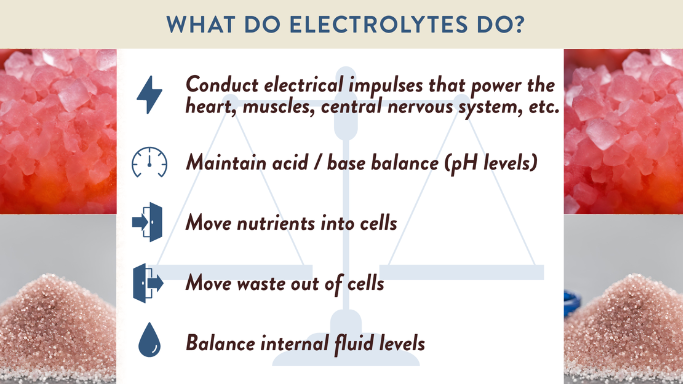Electrolytes are electrically charged minerals that play a crucial role in maintaining the balance of fluids in your body. These minerals help regulate important functions, including muscle contractions, nerve signaling, hydration, and even the pH balance of your blood. Common electrolytes include sodium, potassium, calcium, magnesium, chloride, bicarbonate, and phosphate. Among these, sodium—found in salt—plays a particularly vital role in the body’s overall function.
Understanding Electrolytes: What Are They?
Electrolytes are substances that dissolve in water to form ions, which are electrically charged particles. These ions can either have a positive charge (cations) or a negative charge (anions). In the body, electrolytes are primarily found in blood plasma, urine, and tissue fluids. Their primary function is to conduct electricity, which is essential for many of the body's systems to operate efficiently. Without the proper balance of electrolytes, the body cannot maintain normal cell function, muscle activity, or even nerve function.
When the body is dehydrated or loses too many electrolytes (often through sweating, urination, or vomiting), it can lead to an imbalance that can disrupt normal bodily functions. This is why it's so important to replenish electrolytes through proper hydration and a balanced diet.
How Does Sodium (Salt) Contribute to Electrolyte Balance?
Sodium, a key component of salt, is one of the most important electrolytes in the body. Sodium is essential for maintaining the body's fluid balance and helping nerves and muscles function properly. It does this by helping control the movement of water and other electrolytes into and out of cells, tissues, and organs.
When you consume salt, sodium ions enter the bloodstream and work in conjunction with other electrolytes like potassium and chloride to regulate several physiological processes. Some of the most important functions of sodium include:
-
Maintaining Fluid Balance: Sodium plays a significant role in regulating the amount of water in the body. It helps draw water into the bloodstream and maintain proper hydration in cells. Without enough sodium, the body cannot retain water, leading to dehydration.
-
Supporting Nerve Function: Sodium is essential for nerve cell signaling. Nerve cells use sodium to create electrical signals that allow communication between the brain and the rest of the body. Without enough sodium, nerve signals can become impaired, leading to symptoms like confusion, muscle weakness, or even seizures.
-
Muscle Contractions: Sodium is also involved in muscle function, as it helps muscles contract and relax by maintaining the proper electrical charge within cells. A lack of sodium can cause muscle cramps or spasms, particularly during intense physical activity or in cases of dehydration.
-
Regulating Blood Pressure: Sodium helps regulate blood pressure by balancing the amount of fluid in the bloodstream. When sodium levels are too high, it can cause the body to retain more water, leading to increased blood volume and higher blood pressure. Conversely, too little sodium can lead to low blood pressure (hyponatremia).
Sodium and Potassium: The Dynamic Duo of Electrolytes
While sodium is important for regulating fluid balance, it works in tandem with potassium to keep the body functioning optimally. Potassium is another essential electrolyte found in many foods, such as bananas, leafy greens, and potatoes. Sodium and potassium work together to create electrical gradients across cell membranes, which are necessary for proper nerve function and muscle contraction.
In a balanced state, sodium is concentrated outside of cells, while potassium is found inside. This difference in concentration allows electrical signals to travel across cell membranes, triggering the nerve impulses that control everything from heartbeat to muscle movement. A proper balance of sodium and potassium is crucial for these functions, and an imbalance in one of these electrolytes can lead to serious health issues, such as arrhythmias or muscle weakness.
How Do You Maintain a Healthy Balance of Electrolytes?
Electrolyte imbalances can occur when the body loses too much fluid or when electrolyte levels become too high or too low. This often happens during intense physical activity, illness, or dehydration. To maintain a healthy balance, it's essential to:
-
Stay Hydrated: Drink plenty of water throughout the day, especially after exercise or in hot weather.
-
Consume a Balanced Diet: Eating a variety of foods ensures you get the right amounts of essential electrolytes. Sources of sodium include table salt, sea salt, and processed foods. Potassium can be found in fruits and vegetables like bananas, avocados, and sweet potatoes.
-
Replenish Electrolytes After Physical Activity: During prolonged exercise or sweating, the body loses both fluids and electrolytes. Sports drinks, electrolyte tablets, or coconut water can help replenish lost electrolytes and maintain balance.
-
Avoid Excessive Salt: While sodium is essential, too much salt in the diet can lead to an imbalance that affects blood pressure and kidney function. Aim for the recommended daily intake of sodium (about 2,300 milligrams per day for healthy adults), and adjust based on your activity levels and medical needs.
Conclusion
Electrolytes, especially sodium, are essential to maintaining proper hydration, nerve function, muscle contractions, and overall bodily functions. Sodium, found in salt, plays a central role in balancing fluids, supporting nerve communication, and regulating blood pressure. To maintain a healthy electrolyte balance, it’s important to stay hydrated, consume a variety of nutrient-rich foods, and be mindful of salt intake to prevent dehydration or overconsumption. Salt, in moderation, is vital for good health, and understanding how it contributes to electrolyte balance is key to ensuring our bodies function efficiently.




